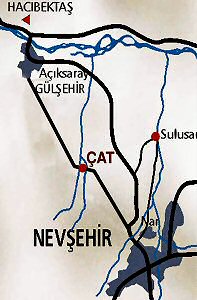 The
initial settlement in the region is estimated to have started in
Neolithic Era between 8000-5500 B.C. Being the homeland of Hittite
civilization during 17-12th century B.C, the region was inhabited
by the Phrygians. After it had been ruled by the Meds, Persians,
Cappadocian Kingdom and King Dikran respectively, the region was
connected to Romans together with the entire Cappadocian region
in 17 A.D. Following the attacks of the Sassanian and Arabians in
11 th century, the Anatolian Seljuks established their dominance
in the region. Afterwards, Ottoman State declared their rule overe
the region in 15th century.
The
initial settlement in the region is estimated to have started in
Neolithic Era between 8000-5500 B.C. Being the homeland of Hittite
civilization during 17-12th century B.C, the region was inhabited
by the Phrygians. After it had been ruled by the Meds, Persians,
Cappadocian Kingdom and King Dikran respectively, the region was
connected to Romans together with the entire Cappadocian region
in 17 A.D. Following the attacks of the Sassanian and Arabians in
11 th century, the Anatolian Seljuks established their dominance
in the region. Afterwards, Ottoman State declared their rule overe
the region in 15th century.
Known as Çat at present, the region is located at the junction
point of the Güvercinlik, Karayatak and Fırınasma valleys covered
with the assorted hues of green during the spring times. Composed
of 650 houses, the current population of the region is 2700. In
the course of millions of years, the land was exposed to various
volcanic explosions as a result of which layers of tuff were formed.
Then on, these layers were exposed to erosion by rain and the waters
of lakes and rivers, resulting in fantastic formations that we see
today as Fairy Chimneys. The most peculiar feature of the
Fairy Chimneys in Çat is their difference to that of the
types-columnar, hat-like of fairy chimneys located in Göreme, Zelve
and Ürgüp. The shapes of these formations exceed the widest imagination
since they have been resembled to a lion, a bird, a crocodile or
a fish, and sometimes to a stone dinosaur...
Throughout the valley, there are several churches that were engraved
into rocks. Furthermore the graves of those who lived in Örenönü-Koyak
locality 3km from the region can also be seen. Besides the bewildering
fairy chimneys and rock churches, Çat valley also receive great
attention with the dovecotes built into the slopes. Having being
adorned with cultural decorations by the artists of the region during
the previous centuries, these dovecotes were built to be benefited
from the dungs of the doves.
The rich panorama is not the only opportunity that the region offers
to those who come to enjoy the beauties of the area. Çat also provides
promenade areas and favourable paths for horseback riding and cycling.
The people of the region make their living through agriculture,
in which viniculture has an important place among the others. Due
to the fertile vineyards of the Çat region, the exquisite grapes
of the Cappadocian region and our country flourish here. As a conclusion
if space seems so remote, a conclusion, if space seems so remote,
come to experience the ethereal and un worldly miracles of the Mother
Nature in Cappadocia.